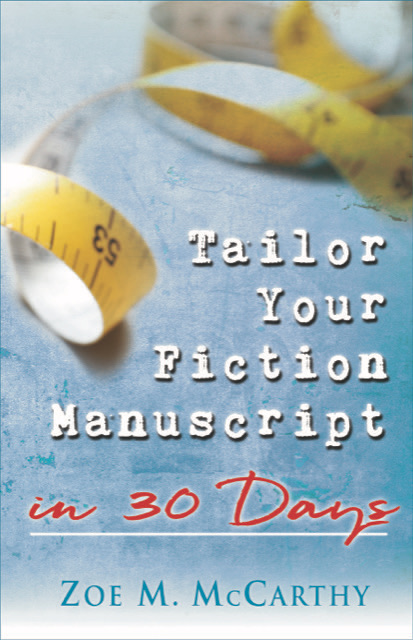

Tailor Your Fiction Manuscript in 30 Days is designed to shape a not-yet submitted, rejected, or self-published manuscript with low ratings into a book that shines. The method can also be a guiding resource for writers starting a manuscript. See details below.
I’m close to finishing a first draft. I’ve avoided editing, except fixes that made the plot work. I’ll edit the draft using the following tips.
Editing Tips
Tip 1 Writing to a word count can help with overwriting. In writing blog posts, my word-count goal is 500 words. It’s amazing how much better the post is when I hunt down wordy or unnecessary phrases and stick close to my goal. Same for a novel.
Tip 2 Don’t allow backstory in the first chapter. Do know your protagonist’s backstory. Do feed what’s necessary into other chapters. Do use backstory in how your character acts and reacts.
Tip 3 Get rid of repetition and explaining. Sometimes repetition comes in a different form but says the same thing. He shoveled in food, bite after bite. Explaining suggests readers aren’t smart enough to get it. He shoveled in food. He was hungry.

Tip 4 Kill your darlings. You have a paragraph you think is clever. If you’re unsure it’s funny, something the character would say, or whether it’s melodramatic, cut your darling.
Tip 5 “Overwriting is a natural result of our own effort to figure out what’s happening in any given scene. Only after we have discovered the core truth can we know what truly belongs and what doesn’t, based on a clearer knowledge of what we’re trying to say and what the scene requires.” “The Too Long and Short of It” by David Corbett (Writer’s Digest September 2019)
Tip 6 Similar to Tip 5 but for the entire book. Understand your character’s past wounds, struggles, and values so you know how he’d react to events, people, and dialogue. Understand what you’re trying to say in your novel. With this knowledge, write a one-sentence theme for your story. Let this guide you so you don’t ramble.
Tip 7 Make sure every scene has purpose to the plot, characterization or the character’s growth arc. Otherwise, cut or change it.

Tip 8 If you describe many body-part movements in a character’s actions, look for a single word. He tightened his fingers on the ball, pulled his arm back, and then threw the ball. Instead, He pitched the ball.
Tip 9 For all genres, add suspense to your scenes, i.e. create and hold back information the reader wants to know. End chapters with a hook or “cliff hanger” to draw readers to the next chapter.
Tip 10 Don’t explain dialogue. Dialogue itself should do the work. Write dialogue that‘s: necessary, unique to the character speaking, shows his emotion, and interesting.
Tip 11 Don’t over describe characters or settings. Allow the reader to visualize with a few key “traits.”
Tip 12 Make sure your ending is satisfying to the reader. Wrap up all the subplots, except maybe one for the next book in a series. Don’t rush the ending. Make sure it’s plausible. Include a surprise or a reward the character receives, such as an understanding or something that relates to an item in the story.
What in a novel do you dislike reading or skip over?

Zoe McCarthy’s book, Tailor Your Fiction Manuscript in 30 Days, is a fresh and innovative refocusing of your novel or novella. Through a few simple—and fun—steps, Zoe helps writers take their not-ready-for-publication and/or rejected manuscripts to a spit-polish finish. Writing is hard work, yes, but it doesn’t have to be difficult. —Eva Marie Everson, best-selling and multiple award-winning author, conference director, president of Word Weavers International, Inc.
If you want to increase your chance of hearing yes instead of sorry or not a fit for our list at this time, this book is for you. If you want to develop stronger story plots with characters that are hard to put down, this book is for you. Through McCarthy’s checklists and helpful exercises and corresponding examples, you will learn how to raise the tension, hone your voice, and polish your manuscript. I need this book for my clients and the many conferees I meet at writer’s conferences around the country. Thank you, Zoe. A huge, #thumbsup, for Tailor Your Fiction Manuscript in 30 Days. —Diana L. Flegal, literary agent, and freelance editor
Tailor Your Fiction Manuscript is a self-editing encyclopedia! Each chapter sets up the targeted technique, examples show what to look for in your manuscript, then proven actions are provided to take your writing to the next level. Whether you are a seasoned writer or a newbie, you need this book! —Sally Shupe, freelance editor, aspiring author
McCarthy crafted an amazing self-help book that will strengthen any writer, whether new or seasoned, with guidance and self-evaluation tools. —Erin Unger, author of Practicing Murder, releasing in 2019
Need to rework your book? Zoe M. McCarthy’s step-by-step reference guide leads you through the process, helping you fight feeling overwhelmed and wrangle your manuscript and into publishable shape in 30 days. Tailor Your Manuscript delivers a clear and comprehensive action plan. —Elizabeth Spann Craig, Twitteriffic owner, bestselling author of the Myrtle Clover Mysteries, the Southern Quilting Mysteries, and the Memphis Barbeque Mysteries http://elizabethspanncraig.com/blog/


 RSS - Posts
RSS - Posts



You asked what in novels I dislike and read over. Italics. One sentence and maybe two I will read. Same goes for non-fiction.
Sometimes, instead of italics, and if I know the reader will understand, I switch to the square ariel font. Much easier to read.
Katheryn, I see so many different thoughts on how to write texts and emails. I’ve used the change in font. I agree on too much italics.
Bravo, Zoe. I’m overjoyed to find someone who keeps their blog posts short. Many posts ramble on … and on … and on … with so much padding that the real information is hidden.
Hi Kathy, thanks for the encouragement.